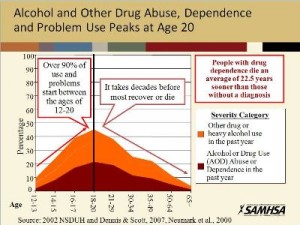Does it really matter if we screen and assess teens for alcohol and drug problems? Most adults, after all, started experimenting with alcohol or other drugs before they turned 21 -- and if they didn't, they almost certainly knew a lot of kids who did. And most of them (though not all) survived into adulthood.
So what's the big deal if we turn a blind eye to identify teen drinking or drugging? Federally-funded research shows why it's a big deal from a public health standpoint:

(Click the image for a larger view.) It's taken from an excellent presentation, "Characteristics, Needs and Strengths of Substance Using Youth by Level of Involvement in the Juvenile Justice System," given by Dr. Michael Dennis, Senior Research Psychologist at Chestnut Health Systems, at the Reclaiming Futures Leadership Institute held in Miami last month. I'll be posting more slides from his presentation soon - stay tuned!
Here's Dr. Dennis' notes on the slide (emphasis added):
This figure shows ... the prevalence of these past year substance use and problems in the height of the graph by age along the bottom.
1- Substance use disorders typically [surface] during adolescence and young adulthood. In fact, 90 percent of all adults with dependence started using under the age of 18, half under the age of 15. Moreover, 90 percent met criteria for abuse or dependence by age 20 – thus it is primarily an adolescent onset disorder.
2- After several decades, the rates of abuse and dependence do decrease as people go into remission, incarceration or die. Epidemiological studies of people with lifetime substance dependence suggest that 58 percent eventually enter sustained recovery (i.e., no symptoms for the past year) -- a rate that is considerably better than the 39 percent average rate of recovery across psychiatric disorders (Kessler, 1994; see also Dawson, 1996; Robins & Regier, 1991).
3 – Notice how the rates of no use go up with age.
One caveat: remember that most youth in the juvenile justice system (at intake, detention, or in secure placement)don't have an alcohol and drug disorder -- though many do. For more information, check out this post: How Prevalent are Substance Abuse and Mental Health Issues in Juvenile Justice? The Answer May Surprise You.
The above story is reprinted with permission from Reclaiming Futures, a national initiative working to improve alcohol and drug treatment outcomes for youth in the juvenile justice system.
